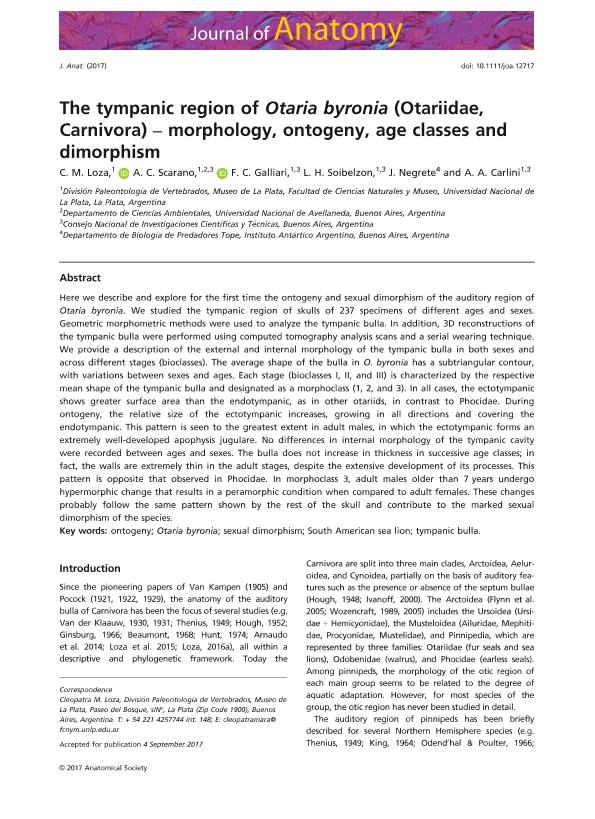Artículo
The tympanic region of Otaria byronia (Otariidae, Carnivora) - morphology, ontogeny, age classes and dimorphism
Loza, Cleopatra Mara ; Scarano, Alejo Carlos
; Scarano, Alejo Carlos ; Galliari, Fernando Carlos
; Galliari, Fernando Carlos ; Soibelzon, Leopoldo Héctor
; Soibelzon, Leopoldo Héctor ; Negrete, Javier
; Negrete, Javier ; Carlini, Alfredo Armando
; Carlini, Alfredo Armando
 ; Scarano, Alejo Carlos
; Scarano, Alejo Carlos ; Galliari, Fernando Carlos
; Galliari, Fernando Carlos ; Soibelzon, Leopoldo Héctor
; Soibelzon, Leopoldo Héctor ; Negrete, Javier
; Negrete, Javier ; Carlini, Alfredo Armando
; Carlini, Alfredo Armando
Fecha de publicación:
10/2017
Editorial:
Wiley Blackwell Publishing, Inc
Revista:
Journal Of Anatomy
ISSN:
0021-8782
Idioma:
Inglés
Tipo de recurso:
Artículo publicado
Clasificación temática:
Resumen
Here we describe and explore for the first time the ontogeny and sexual dimorphism of the auditory region of Otaria byronia. We studied the tympanic region of skulls of 237 specimens of different ages and sexes.Geometric morphometric methods were used to analyze the tympanic bulla. In addition, 3D reconstructions of the tympanic bulla were performed using computed tomography analysis scans and a serial wearing technique. We provide a description of the external and internal morphology of the tympanic bulla in both sexes and across different stages (bioclasses). The average shape of the bulla in O. byronia has a subtriangular contour, with variations between sexes and ages. Each stage (bioclasses I, II, and III) is characterized by the respective mean shape of the tympanic bulla and designated as a morphoclass (1, 2, and 3). In all cases, the ectotympanic shows greater surface area than the endotympanic, as in other otariids, in contrast to Phocidae. During ontogeny, the relative size of the ectotympanic increases, growing in all directions and covering the endotympanic. This pattern is seen to the greatest extent in adult males, in which the ectotympanic forms an extremely well-developed apophysis jugulare. No differences in internal morphology of the tympanic cavity were recorded between ages and sexes. The bulla does not increase in thickness in successive age classes; infact, the walls are extremely thin in the adult stages, despite the extensive development of its processes. This pattern is opposite that observed in Phocidae. In morphoclass 3, adult males older than 7 years undergo hypermorphic change that results in a peramorphic condition when compared to adult females. These changesprobably follow the same pattern shown by the rest of the skull and contribute to the marked sexual dimorphism of the species.
Archivos asociados
Licencia
Identificadores
Colecciones
Articulos(CCT - LA PLATA)
Articulos de CTRO.CIENTIFICO TECNOL.CONICET - LA PLATA
Articulos de CTRO.CIENTIFICO TECNOL.CONICET - LA PLATA
Articulos(SEDE CENTRAL)
Articulos de SEDE CENTRAL
Articulos de SEDE CENTRAL
Citación
Loza, Cleopatra Mara; Scarano, Alejo Carlos; Galliari, Fernando Carlos; Soibelzon, Leopoldo Héctor; Negrete, Javier; et al.; The tympanic region of Otaria byronia (Otariidae, Carnivora) - morphology, ontogeny, age classes and dimorphism; Wiley Blackwell Publishing, Inc; Journal Of Anatomy; 232; 1; 10-2017; 1-18
Compartir
Altmétricas



